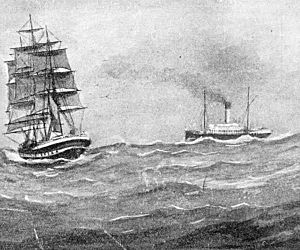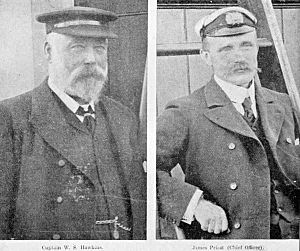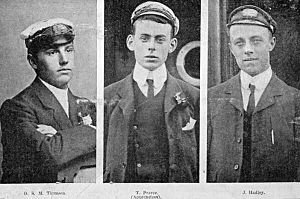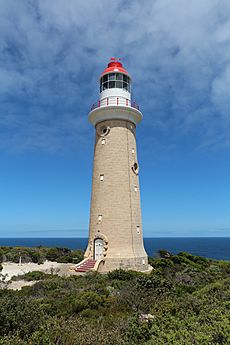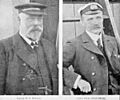Loch Vennachar facts for kids
class="infobox " style="float: right; clear: right; width: 315px; border-spacing: 2px; text-align: left; font-size: 90%;"
| colspan="2" style="text-align: center; font-size: 90%; line-height: 1.5em;" | 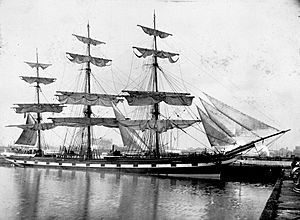
|} The Loch Vennachar was a large sailing ship, known as a clipper. She was built in Scotland in 1875. This ship was made of iron and had three masts. She was lost at sea with everyone on board in 1905, off the coast of South Australia.
The Loch Vennachar worked for the Glasgow Shipping Company her whole life. This company was often called the "Loch Line". This was because all their ships were named after Scottish lochs (lakes). The Loch Vennachar was named after Loch Venachar.
The ship had a tough life. In 1892, a strong cyclone broke her masts in the Indian Ocean. She survived this. In 1901, a steamship crashed into her in the Thames Estuary, causing her to sink. But she was lifted out of the water, fixed, and put back to work. Sadly, in 1905, she sank again near Kangaroo Island and was never seen again.
In 1976, underwater explorers called marine archaeologists found the wreck of the Loch Vennachar. It was found near West Bay, Kangaroo Island. Today, the wreck is protected by a law called the Historic Shipwrecks Act 1976. Some parts of her anchors were found in 1980. They are now kept on Kangaroo Island.
Contents
| History | |
|---|---|
| Name | Loch Vennachar |
| Namesake | Loch Venachar |
| Owner |
|
| Operator | Glasgow Shipping Co |
| Port of registry | Glasgow |
| Builder | J&G Thomson, Dalmuir |
| Launched | 4 August 1875 |
| Maiden voyage | 9 September 1875 |
| Identification | |
| Fate | sank September 1905 |
| General characteristics | |
| Type | clipper |
| Tonnage | 1,557 GRT, 1,485 NRT |
| Length | 250.1 ft (76.2 m) |
| Beam | 38.3 ft (11.7 m) |
| Sail plan | 3-masted square-rigged ship |
| Speed | 15 knots (28 km/h) |
| Notes | sister ship: Loch Garry |
- The Final Journey
- Crew on the Last Voyage
- Cape du Couedic Lighthouse
- Finding the Wreck
- Studying the Wreck
- The Wreck Today
- See also
- Images for kids
Building a Clipper Ship
The Loch Vennachar was built by James and George Thomson. Their shipyard was in Dalmuir, right on the River Clyde in Scotland. The ship was launched into the water on August 4, 1875.
She was a very long ship, about 250.1 ft (76.2 m) (76.2 meters) long. Her width, called her beam, was 38.3 ft (11.7 m) (11.7 meters). The depth of her main storage area, called her hold, was 22.4 ft (6.8 m) (6.8 meters). Her total weight, or tonnage, was 1,557 GRT gross tons.
The Glasgow Shipping Company officially registered the Loch Vennachar in Glasgow. Her special UK number was 71748. Her unique code letters were PCVQ.
When first built, the ship had a certain type of masts that made her a bit wobbly. So, they changed her masts to a different design. This new design helped her stay more stable in the water.
The Ship's Journeys
The Loch Vennachar mostly carried wool from Adelaide and Melbourne in Australia to Britain. She usually carried about 5,500 bales of wool. When sailing from Britain to Australia, she carried other goods and also passengers.
Many different captains commanded the Loch Vennachar during her years at sea. Captain Francis Wagstaff led her first trip in September 1875. Later, Captain William Robertson took over but sadly died in 1878. James S Ozanne, who was the First Officer, then became captain until 1884. Captain William H Bennett was captain until 1904. The last captain was William S Hawkins, who commanded her on her final journey in 1905.
Surviving a Cyclone
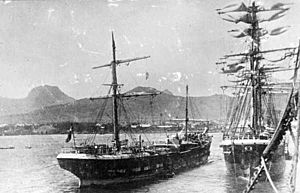
In June 1892, the Loch Vennachar faced a terrible cyclone in the Indian Ocean. On June 3, the weather started getting bad. The crew quickly made her sails smaller. Early the next morning, huge waves and a strong gale hit the ship. Two giant waves crashed over her deck. These waves broke all three of her masts. With no masts to keep her steady, the ship rolled dangerously in the rough seas.
After nine days, the storm calmed down. The crew managed to set up a temporary spar (a pole for sails) at the front. They also put a small sail on the damaged mizzen mast (the back mast). Five weeks later, she reached Port Louis in Mauritius. She had to wait there for five months for new masts to arrive from England. Once they came, she was fixed in just ten days. The repairs cost a lot of money, £9,071. Captain Bennett was given a special award, the Lloyd's Medal, for saving the ship and crew.
Collision in the Thames
On November 12, 1901, the Loch Vennachar was anchored in the Thames Estuary in England. At about 4:15 AM, a steamship called Cato crashed into her front right side. The Loch Vennachar sank. One sailor was badly hurt, but the crew quickly got into the ship's boats. All 30 crew members were saved. Sadly, six of her seven ship's cats were lost.
The ship was lifted from the water on December 9. It cost £17,000 to repair her. After the repairs, she was able to go back to work.
The Final Journey
In late June 1905, the Loch Vennachar left Glasgow, Scotland, heading for Adelaide, Australia. She was carrying a mix of goods, including 20,000 bricks. On September 6, 1905, another ship, the Yongala, passed her. This was about 160 nautical miles (300 km) west of the Neptune Islands. The captains of both ships exchanged "all's well" signals, meaning everything was fine. The captain of the Yongala said the Loch Vennachar looked beautiful, sailing fast with all her sails full. This was the last time anyone ever saw the Loch Vennachar.
On September 29, a small boat called the Annie Watt arrived in Adelaide. Its captain reported finding a roll of blue printing paper. This was 18 miles northwest of Kangaroo Island. The paper was identified as part of the Loch Vennachar's cargo. Three weeks later, more parts of her cargo started washing up on the rocky coast of Kangaroo Island. This confirmed that the ship was lost.
Rescue ships were sent to search for the wreck and any survivors. Weeks of searching by government and local fishing boats found only floating debris and the body of a young sailor. He was never identified and was buried in the sand dunes of West Bay. The search was stopped on October 12. At the time, people thought the Loch Vennachar had crashed on some rocks called Young Rocks.
Crew on the Last Voyage
Newspapers first listed people who might have been on the ship in late September 1905. This list had 23 names. It was made from letters waiting for the ship at the agent's office in Adelaide. Later, it was found that two apprentices, S.C. Brown and Robert Andrews, had moved to other ships.
In November 1905, a final list of the crew was published. This list showed that there were no passengers on the last trip. The list included:
- William S. Hawkins, master (captain)
- James Priest, mate (first officer)
- Charles Radcliffe, second mate
- Fred. W. Lake, third mate
- James Reid, carpenter
- W. Molseed, steward
- W. McLean, cook
- R. Simpson, sailmaker
- Eugen Broberg, A.B. (able seaman)
- Donald Mathieson, A.B.
- A. Anderson, A.B.
- E: McEwan, A.B.
- Thomas Anderson, A.B.
- Hugh Humphreys, A.B.
- Alexander Dunlop, A.B.
- M. Jenson, A.B.
- David Hanson, A.B.
- E. Holden, A.B.
- John Bickle, A.B.
- William Barry, A.B.
- Edward McPhie, O.S. (ordinary seaman)
- William Turnbull, O.S.
- William Martin, O.S.
- Joseph W. Hadley, apprentice
- Thomas W. Pearce, apprentice
- D.S.B. Thomson, apprentice
- Horace Eastwood, apprentice
One of the apprentices, Thomas Pearce, was well-known. His father was one of only two survivors from another shipwreck, the Loch Ard, in 1878. Also, his step-grandfather died when his ship, the SS Gothenburg, was lost in 1875.
Cape du Couedic Lighthouse
The loss of the Loch Vennachar happened after another ship, the Loch Sloy, was lost in 1899. In 1902, a group called the Marine Board of South Australia suggested building a lighthouse on Cape du Couedic. They believed a lighthouse there could have stopped both ships from being lost.
Building the lighthouse started in 1907. The Cape du Couedic Lighthouse officially lit up on June 27, 1909. In 1908, the northern tip of West Bay was named Vennachar Point to remember the ship.
Finding the Wreck
In February 1976, a group called the Society for Underwater Historical Research (SUHR) started looking for the wreck. They searched off the west coast of Kangaroo Island. On February 24, the weather was too bad for diving. So, they searched the shore near West Bay. They found a brick with the letters "GLAS...OW" on it.
On February 26, the weather was good for scuba diving. Three SUHR divers and two local divers searched the sea where the brick was found. They found the wreck at a depth of 12 metres (39 ft) (about 39 feet). All of her anchors were still in place. This suggested that the crew did not try to drop anchor to stop the ship from hitting the cliff.
Studying the Wreck
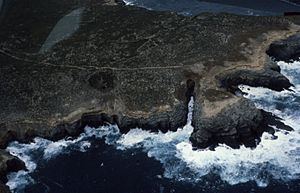
After the SUHR group asked for help, the leader of South Australia, Don Dunstan, made an announcement. On December 11, 1976, he said the SUHR would go on a big trip in February 1977 to study the wreck. The government would help by providing police divers and other support. He also made the wreck site a special historic reserve.
In February 1977, a team of 34 people set up camp at West Bay for two weeks. The weather was not good for diving on the Loch Vennachar at first. So, they spent the first week diving on another shipwreck. The second week was spent at the Loch Vennachar wreck. The team mapped the wreck, took many photos, and brought up some items to preserve them.
The team suggested saving one of the ship's large anchors. This was done in 1980. The SUHR worked with the government and a local diving club. On March 31, a part of the anchor was brought up from the wreck. The next day, another part was recovered. These parts were kept in the water until they could be moved to Kingscote. From there, they were taken to Port Adelaide for cleaning and preservation.
The anchor was cleaned in Adelaide. It was then returned to Kangaroo Island. It is now on display at the Flinders Chase Homestead in the Flinders Chase National Park. A special ceremony was held on March 26, 1982, to celebrate its return.
The Wreck Today
The Loch Vennachar wreck site has been protected by the Commonwealth Historic Shipwrecks Act 1976 since October 1980. Its exact location is 35°52′48″S 136°31′12″E / 35.88000°S 136.52000°E. The area around the wreck is also a protected historic reserve.
The grave of the unidentified sailor is still at West Bay. The original wooden cross, made from parts of the shipwreck, was damaged. Now, there is a replica wooden cross there. By 2006, the large anchor had been moved. It is now next to the visitors' car park on the south side of West Bay.
See also
- List of clipper ships
- List of shipwrecks of Australia
- List of disasters in Australia by death toll
Images for kids


